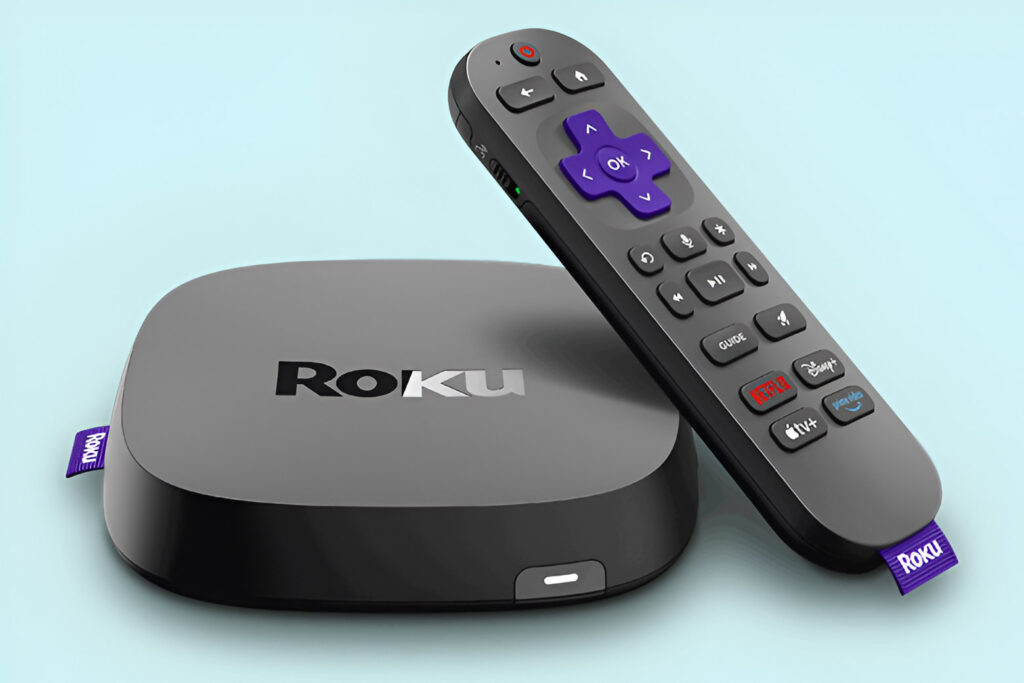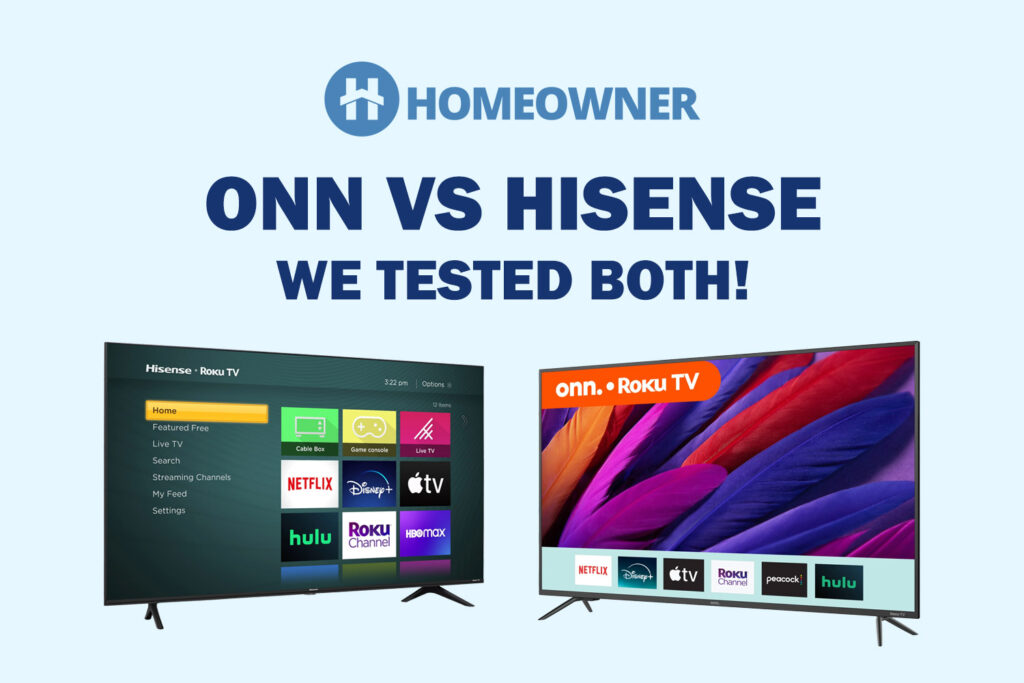In this post:
- 1. Best WiFi 6E Tri Band Router: Netgear Nighthawk RAXE500
- 2. Best for Gaming: ASUS ROG GT-AX11000
- 3. Best For 2000-2500 Sq Ft : TP-Link Archer AX90
- 4. Best Duo-Band Mesh Router: Linksys Atlas Pro 6
- 5. Best Value For Money: TP-Link Archer AXE75
- 6. Cheap Yet Best Tri-Band Router: Linksys MR9000
- Frequently Asked Questions
- Verdict
A tri-band router is a type of router that comes with 3 frequency bands (one 2.4GHz and two 5GHz bands). Although, a basic dual-band router is suffice for most houses. However, if you live in a network congested and are facing signal interference, you should consider getting a tri-band WiFi router.
But how to find the best device that suits your need? With so many options in the market, choosing the right one can be challenging. That's why I tested over 13 popular 3-band routers for 4 weeks and have ranked and reviewed the 6 best options.
Since you're here, you already know the benefits of the additional 5GHz band in a tri-band WiFi router. So I won't write a lot about the advantages, but in short, the additional band makes the device perform better, provide better wireless coverage, and make your networking setup futureproof.
Note: You shouldn't buy a router just because it has 3 bands, there are many other things to consider such as coverage area, security features, app support, speed capacity, compatibility with your internet plan, etc.
1. Best WiFi 6E Tri Band Router: Netgear Nighthawk RAXE500
Looking for the best tri-band long-range wireless router ? The Netgear Nighthawk RAXE500 with WiFi 6E is my favorite pick. With a coverage area upto 3,500 sq ft, 60 device support, and optimized performance for various scenarios, you'll miss nothing.
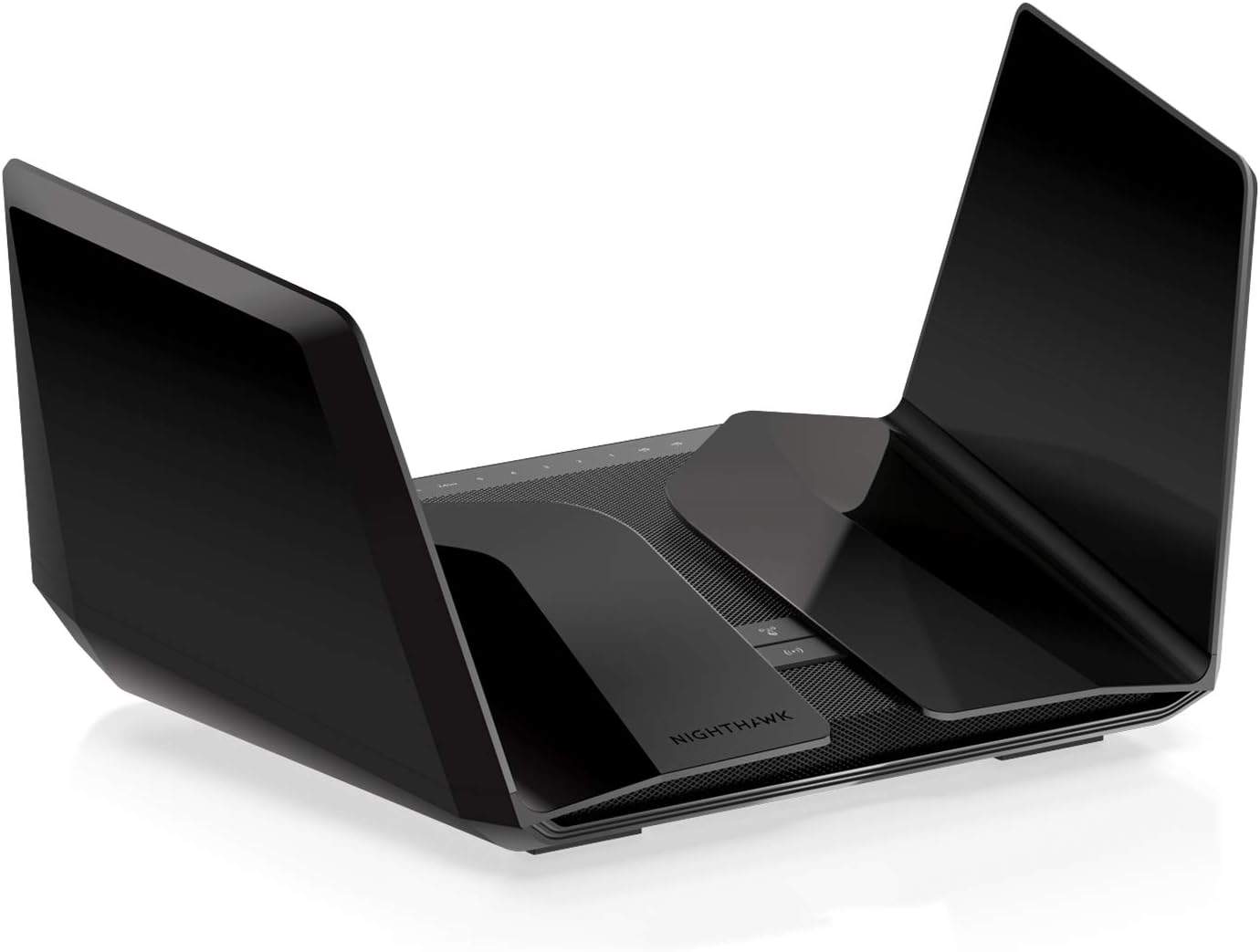
- Wireless Standard: Wi-Fi 6E
- WiFi Range: Up to 3,500 Sq Ft
- Supported Internet Plan: Up to 2 Gbps
- 2.4GHz Speeds: 1200 Mbps
- 5GHz Speeds: 4800 Mbps
- 6GHz Speeds: 4800 Mbps
- Number of Devices Supported: 60
- Ports: 1 x 2.5G + 1 x Gig WAN + 4 x Gig LAN + 2 x USB 3.0
- Processor: 1.8GHz Quad-Core
- RAM & NAND Memory: 1GB + 512MB
- App Support: Yes
On the top of my list is presenting to you a top-tier routing device by Netgear that delivers a rock-solid performance courtesy of an additional 6GHz band, cutting-edge processing ability, multi-gig ports, and powerful antennas. Compared to its predecessor, RAXE450, there aren’t many upgrades aside from speeds, but RAXE500’s performance was very stable and consistent.
Why is it a suitable choice?
Netgear Nighthawk RAXE500 is adorned with the latest Wi-Fi 6E protocol with tri-band support, including an additional 6GHz band that takes its maximum throughput capacity to 11000 Mbps, with respective band-wise speeds:
- 6GHz: 4.8 Gbps,
- 5GHz: 4.8 Gbps
- 2.4Ghz: 1.2 Gbps.
But that’s the speed measured in an ideal setup with a few or zero interferences. In real-time with Xfinity 2 Gig plan, download and upload speeds over the 6GHz band averaged 1.9 Gbps and 879 Mbps, respectively. At the same time, respective speeds over the 5GHz band were 1.75 Gbps and 805 Mbps. At the same time, the farther band recorded speeds of 1.1 Gbps and 487 Mbps.
Thanks to the newer 6GHz band in the WiFi 6E standard, there are no interferences from other networks, making the data packets over the channels travel much faster. Whether you’re playing games, watching movies, or attending video calls, there are zero throttles or latencies.
Ports & Wired Speed
Netgear has done an excellent job in this department, including a 2.5Gig port and five Ethernet ports with link aggregation support. So, you h got access to multi-gig speeds, whether connected wireless or wired. It took me around 3-4 mins to download a 247GB file with speed values reaching as high as 2010 Mbps and upload speeds of 947 Mbps.
WiFi Coverage & Device Capacity
Concerning coverage, the routing device performed exceedingly well courtesy of eight high-amplified antennas with beamforming technology; its signal range reaches a value of 3,000 Sq Ft. So, any average-sized apartment or workspace should be a perfect fit for this router.
Other than that, networking technologies like MU-MIMO and OFDMA let you send powerful signals over multiple devices. You can connect up to 40 devices at a stretch without experiencing a signal drop.
Security Features
Security of users and their data has always been a concern for Netgear, and their devices ingrain adequate features to keep themselves safe. With Netgear RAXE500, you have features like VPN support, guest network access, guest network access, WPA3 security protocol, and standard-based WiFi security. So, your home network and connected devices are now safe and sound.
The networking device also offers a premium security feature with Armor 2.0. At a $6.99 monthly subscription, there are some additional features like malware blocking, threat identification, and a firewall to restrict unknown devices.
Conclusion
Priced at around $450, Nighthawk RAXE500 is probably the costliest networking device out there. But features like Wi-Fi 6E technology with an additional 6GHz band, multi-gig port, MU-MIMO, and OFDMA compensate for its premium price. Its security is also decent enough to protect your devices and network from external agents, and there’s also an option to upgrade it.
For more details, read my dedicated review of the Netgear RAXE50.
Pros
- Utilizes the 6GHz band
- Multi-gig ports
- Link aggregation support
- Supports 160MHz channel bandwidth
- Decent coverage
Cons
- Some features need a subscription
- Expensive
2. Best for Gaming: ASUS ROG GT-AX11000
Looking for a gaming router? Coming from the brand loved by gamers, the ASUS ROG GT-AX11000 offers low latency gaming and amazing port management. Don't think twice.
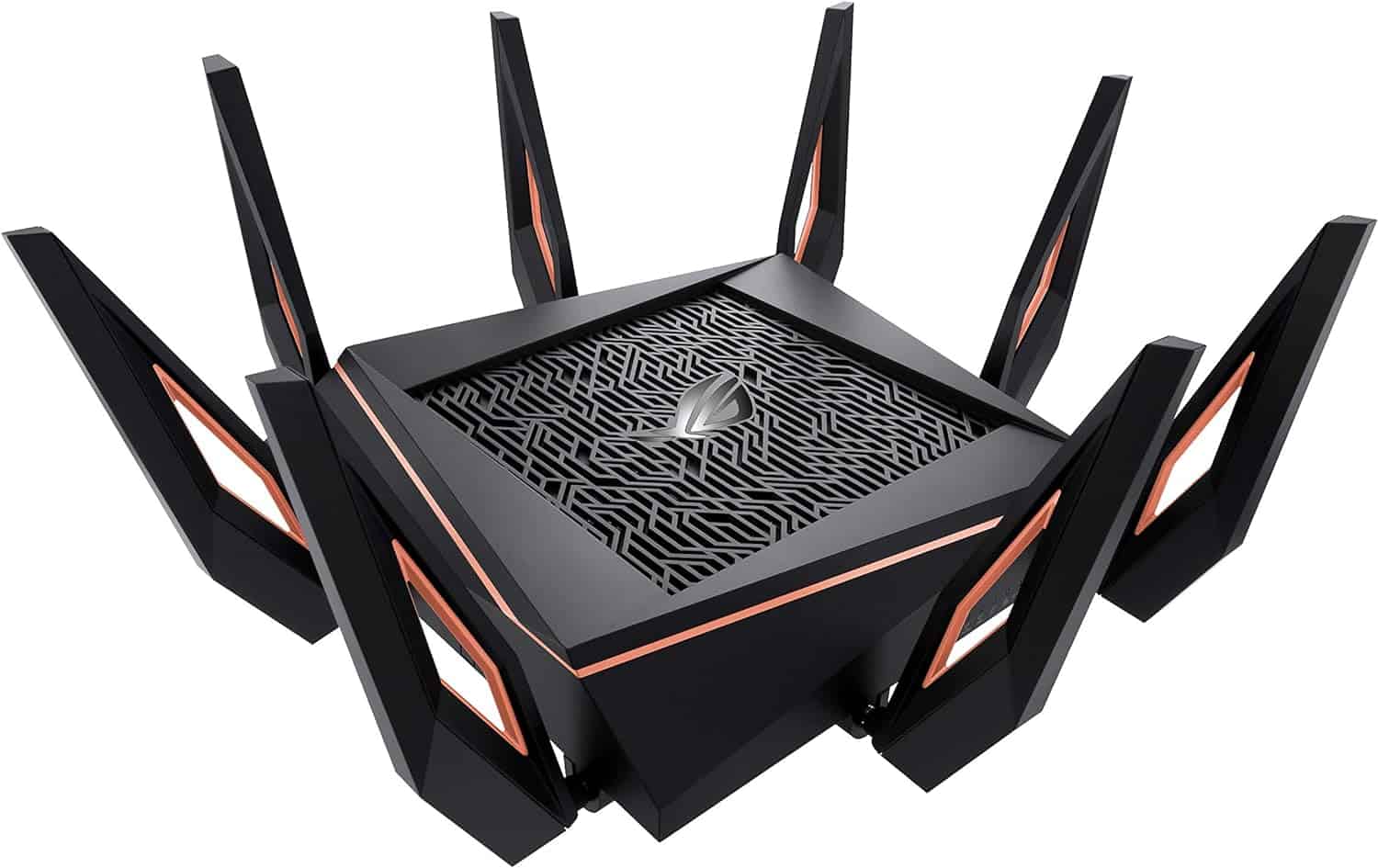
- Wireless Standard: Wi-Fi 6 (802.11ax)
- WiFi Range: Up to 3,000 Sq Ft
- Supported Internet Plan: Up to 2 Gbps
- 2.4GHz Speeds: 1148 Mbps
- 5GHz Speeds: 4804 + 4804 Mbps
- Number of Devices Supported: 100+
- Ports: 1 x 2.5G LAN + 1 x Gig WAN + 4 x Gig LAN + 2 x USB 3.1
- Processor: 1.8GHz Quad-Core
- RAM & NAND Memory: 1GB + 256MB
- App Support: Yes
Asus Republic of Gamers (ROG) series of devices are designed to take your gaming experience to a whole new level. Its ROG GT-AX11000 offers the fastest and stablest of connections, courtesy of some futuristic technologies like Wi-Fi 6, multi-gig port, link aggregation support, cutting-edge processor, and powerful RAM.
Besides, the device brings a lot of upgrades over ROG Rapture GT-AX6000 with respect to the throughput capacity, coverage, and overall performance.
Why is it a suitable choice?
The Wi-Fi 6 support and a battle-ready processor take the maximum throughput capacity of the router to 11000 Mbps, with respective band-wise speeds of:
5GHz (2): 4804 Mbps, 5GHz (1): 4804 Mbps, 2.4GHz: 1148 Mbps
With such massive throughput capacity, it’s fair to pair it with a 2 Gbps Xfinity plan, and here are the results for the respective bands. Over the 5GHz bands, respective download and upload speeds fared out at 1.87 Gbps and 857 Mbps, while for the 2.4GHz band, it was 845 Mbps and 402 Mbps. Such high throughput values over bands allow the router to take over 45 gaming devices at once.
Ports & Wired Speed
Asus RT-AX11000 has a similar setup of ports as in Netgear RAXE500. Courtesy of the 2.5G port and ethernet ports with link aggregation, you have multi-gig speeds in your hands. Now connect any of your available devices and get a maximum speed of 1.97 Gbps and 879 Mbps for downloads and uploads. Availability of a few extra Mbps means your gaming and streaming devices now run much faster.
WiFi Coverage & Device Capacity
Courtesy of eight beamforming-supported antennas, connecting devices over a 2,500 Sq Ft area felt like a cakewalk. The availability of MU-MIMO and QoS makes it possible to connect a multitude of devices without any issues. Although the stated theoretical capacity is 100, trust me when I say that you can connect over 50 devices at a time, of course, lag-free.
The device also comes with AiMesh support, which lets you pair it with any compatible router and extend your coverage to a few thousand square feet.
Security Features
When it comes to Asus networking devices, you don’t have to worry about security. Keeping up to the expectations, RT-AX11000 comes with a lifetime-free AiProtection pro feature, with access to advanced features like malware-infected device blocking, security assessment, malicious site blocking, WPA3 protocol, and two-way IPS. What more would you need?
The router further integrates smart parental controls like customized internet scheduling, creating profiles, content filters, internet pausing, and others. That’s particularly important for digital mothers to ensure their child isn’t exposed to anything obscene or dangerous online.
Conclusion
In conclusion, this ASUS router is a wholly-packed router that presents the capabilities of a powerful networking device to become the best for gaming. Its throughput capacity is high, and you get crystal-clear signals every time you connect. And its best feature is Aiprotection pro that inculcates some advanced security features to keep any of your devices safe and secure.
However, a 5GHz additional band over 6GHz in my previous recommendation has pushed the router into the second position.
Pros
- AiMesh supported
- Superfast tri-band router
- Smart parental controls
- Lifetime free network security tools
Cons
- Complicated web browser interface
3. Best For 2000-2500 Sq Ft : TP-Link Archer AX90
Looking for a wireless router that can provider wireless coverage for a 2000-2500 sq ft house or office, the TP Link Archer AX90 with WiFi 6 (AX6600) shouldn't be ignored. It's one of the most reliable routers. Also ranked #1 in my list of routers for 2000 sq ft coverage.
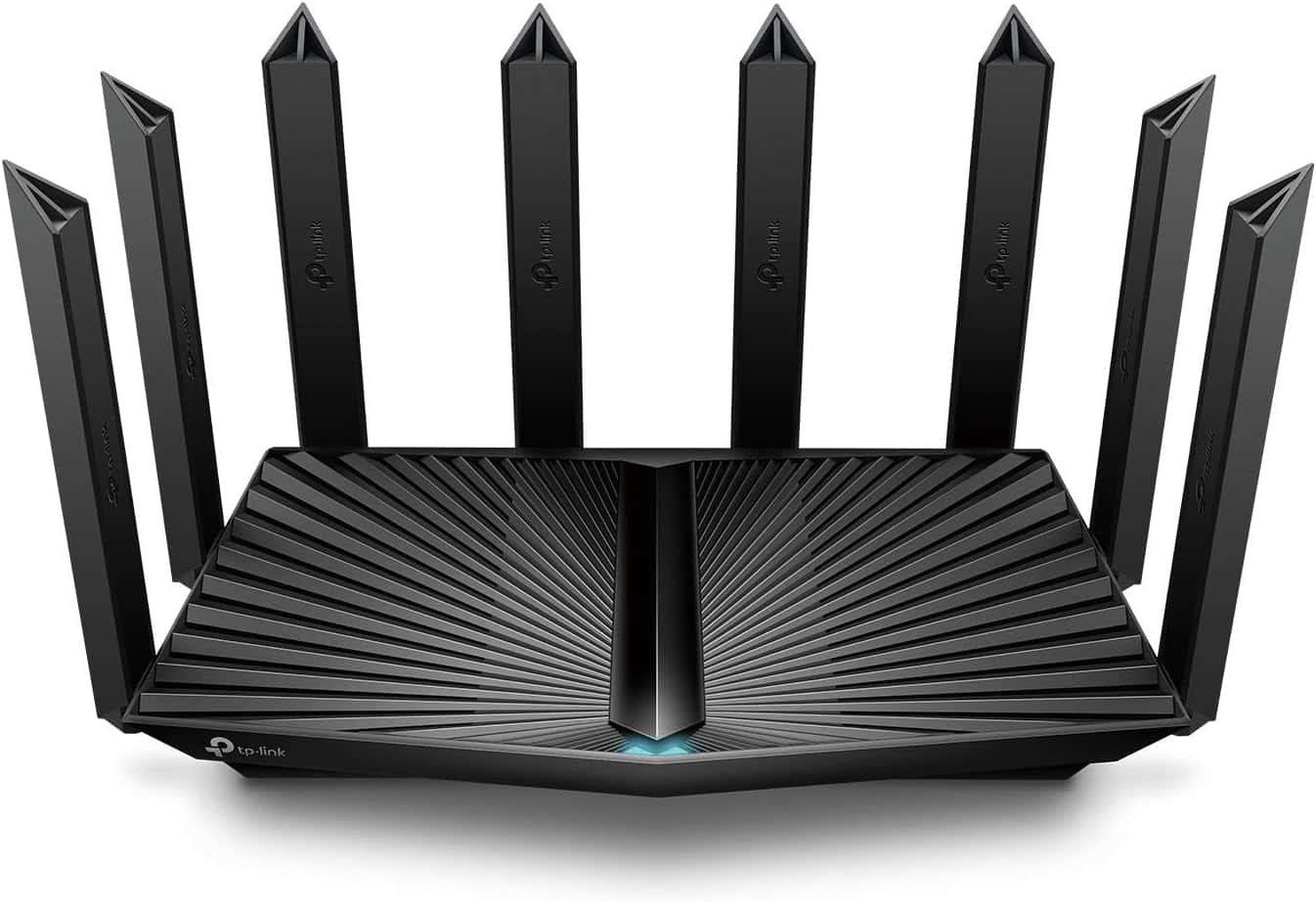
- Wireless Standard: Wi-Fi 6 (802.11ax)
- WiFi Range: Up to 2,500 Sq Ft
- Supported Internet Plan: 2 Gig
- 2.4GHz Speeds: 574 Mbps
- 5GHz Speeds: 4804 + 1201 Mbps
- Number of Devices Supported: 40+
- Ports: 1 x 2.5Gig WAN/LAN + 1 x Gig WAN/LAN+ 3 x Gig LAN + 1 x USB 3.0 + 1 x USB 2.0
- Processor: 1.5GHz Quad-Core
- RAM & NAND Memory: 512MB + 128MB
- App Support: Yes
Any list of best routers is incomplete without a TP-Link offering, so here’s Archer AX90 for you. Aside from tri-band support, some notable features like a multi-gig port, faster throughput, powerful processor, and great RAM make it a much bigger upgrade over TP-Link’s flagship model, Archer AX73. Let’s discuss more what the router has in store.
Why is it a suitable choice?
TP-Link Archer AX90, with powerful wireless technologies, boasts a maximum throughput capacity of 6600 Mbps, and here is its breakdown:
5GHz (1): 4804 Mbps, 5GHz (2): 1201 Mbps, 2.4GHz: 574 Mbps
Similar to my above recommendations, I paired this router with the available Xfinity 2 Gbps plan, and its band-wise speeds were decent enough. The additional 5GHz band being the strongest, could give out maximum download and upload speeds of 1.79 Gbps and 805 Mbps, respectively. Whereas the other 5GHz clocked speeds at 1.1 Gbps and 512 Mbps.
At the same time, the farther band being the weakest, clocked speeds for downloads and uploads at 557 Mbps and 214 Mbps. The additional 5GHz band is actually the star of this device, and devices connected to it played out games like CS: GO, Fortnite, and others at 102fps and a ping of 2ms.
Ports & Wired Speed
Like my previous recommendations, the routing device ingrains a multi-gig port with a maximum throughput capacity of 2.5 Gbps. Connected to it, the downloads and uploads carried forward at 1.94 Gbps and 915 Mbps. While you get similar speeds from Ethernet ports with link aggregation support, provided you have two IPs in place.
WiFi Coverage & Device Capacity
TP-Link Archer AX90, despite featuring eight antennas, has a massive coverage drop compared to Netgear Nighthawk RAXE500. But its antennas are able to cover an area between 2,000 and 2,200 Sq Ft, the size of a mid-sized apartment or a small office. Technologies like MU-MIMO and QoS further strengthen its signals, and it can transmit strong signals to 35 devices at once.
Security Features
Concerning security, its basic features with Homeshield, like guest access, VPN, SPI firewall, auto-firmware updates, and others, are almost identical to my previous recommendations. Besides, there are a few smart parental controls like age-based filters, WiFi pausing, and scheduling WiFi pauses. Although these might not sound little, they can ensure the safety of your personalized network.
TP-Link also provides an option to upgrade your security to HomeShield Pro, which gives access to advanced features like threat detection and elimination, identifying malicious sites, and others. Besides, there’re some extra parental control features like setting online time limits and rewarding your kids with extra time for completing their homework or any household chores.
Conclusion
To conclude, TP-Link Archer AX90 is a powerful and reliable tri-band routing device that can fulfill the bandwidth needs of your household and workspace devices. Its multi-gig port gives your gaming devices an extra bandwidth boost to run your heavy games easily.
However, its coverage is less than that of my previous recommendation, and access to advanced security features requires a subscription.
Pros
- Great throughput capacity
- Decent coverage
- Multi-gig port
- Link aggregation
Cons
- Some features need a subscription
4. Best Duo-Band Mesh Router: Linksys Atlas Pro 6
If you're living in a very large house that's above 5000 sq ft and need a tri-band wireless solution, then you'll have to get a mesh WiFi system. And the Linksys Atlas Pro 6 is a powerful option!
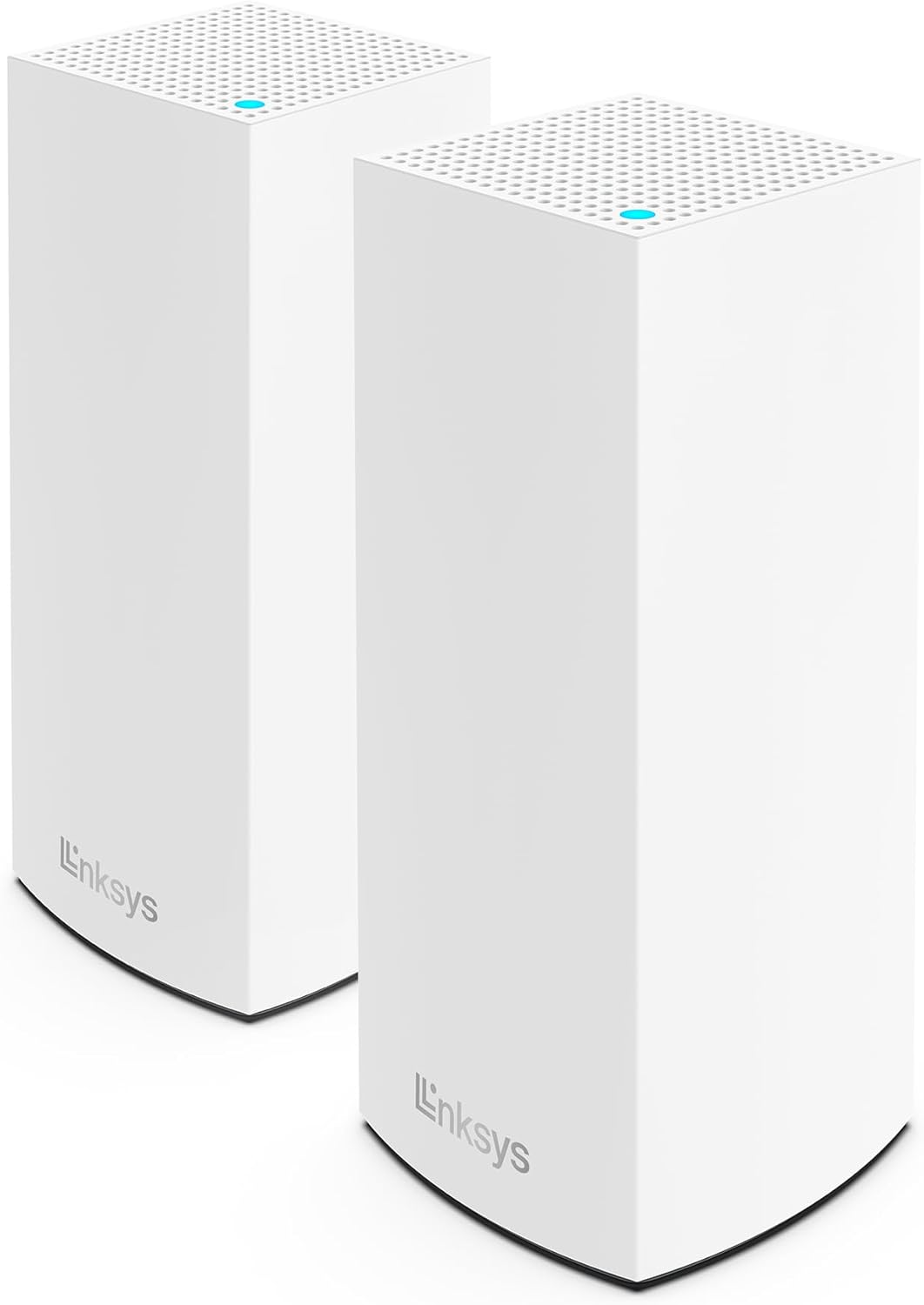
- Wireless Standard: Wi-Fi 6 (802.11ax)
- WiFi Range: Up to 6,000 Sq Ft
- Supported Internet Plan: Up to 1 Gbps
- 2.4GHz Speeds: 1147 Mbps
- 5GHz Speeds: 2402 Mbps
- Number of Devices Supported: 100
- Ports: 1 x Gig WAN + 4 x Gig LAN + 1 x USB 3.0
- Processor: 2.2GHz Quad-Core
- RAM & NAND Memory: 1GB + 512MB
- App Support: Yes
If you have a large home and are looking for a powerful tri-band mesh router to eliminate potential dead zones and weak spots in your space, then Linksys Atlas Pro 6 should be your go-to model. Barring coverage, its throughput capacity is great, and courtesy of its cutting-edge processor, you can expect a power-packed performance every time, much higher than its predecessor.
Why is it a suitable choice?
Supporting 802.11ax WiFi 5 standards, the dual-band router has a combined maximum throughput speed of 5.3 Gbps, with individual speeds as follows:
5GHz: 2402 Mbps
2.4GHz: 1147 Mbps
In my throughput tests with the 1 Gig Xfinity plan, the 5GHz band had download speeds of 987 Mbps, while respective upload speeds was 457 Mbps. At the same time, the 2.4GHz band had respective speeds of around 687 Mbps and 242 Mbps. In this case, the decent performance of the faraway band dictates its overall strong wireless capability.
With such a strong throughput performance, you can concurrently connect any bandwidth-demanding devices, like laptops, personal computers, gaming consoles, and mobile devices, to run lag-free tasks.
Ports & Wired Speed
Unlike my previous recommendations, there isn’t any 2.5G port to experience multi-gig speeds on your devices. But, five Ethernet ports on its rear panel can get you speeds of 1015 Mbps and 521 Mbps, elevating your gaming and streaming experience. The latencies are further reduced, and 8K movies on Netflix run without any inconsistencies.
WiFi Coverage & Device Capacity
Being a mesh router, you can expect a strong performance in this department, and it delivers, rightly so. Its internally encased powerful antennas could easily send strong signals across an entire 3,700 Sq Ft mansion-style house. And it could even encase my garage, basement parking, and garden with powerful signals, adding up its overall coverage to 4,400 Sq Ft.
Besides, technologies like MU-MIMO and beamforming allow connecting up to 52 devices without any throttles or inconsistencies.
Security Features
In terms of security features, you won't get any advanced security upgrades like you would with TP-Link or Netgear devices. Guest access, VPN, and the WPA3 security protocol are all included right out of the box. As a result, data transmitted across the network is encrypted and thus secure.
Conclusion
In conclusion, if you are experiencing weak spots and a low network in certain parts of your house, it’s indeed a fair investment. Besides, its speed outputs and security features are decent enough to qualify as the best Wi-Fi 6 duo-band mesh router in the market.
Pros
- MU-MIMO and beamforming
- Great coverage
- Decent speeds
- Decent security features
Cons
- Chunky design
- Bit pricy
5. Best Value For Money: TP-Link Archer AXE75
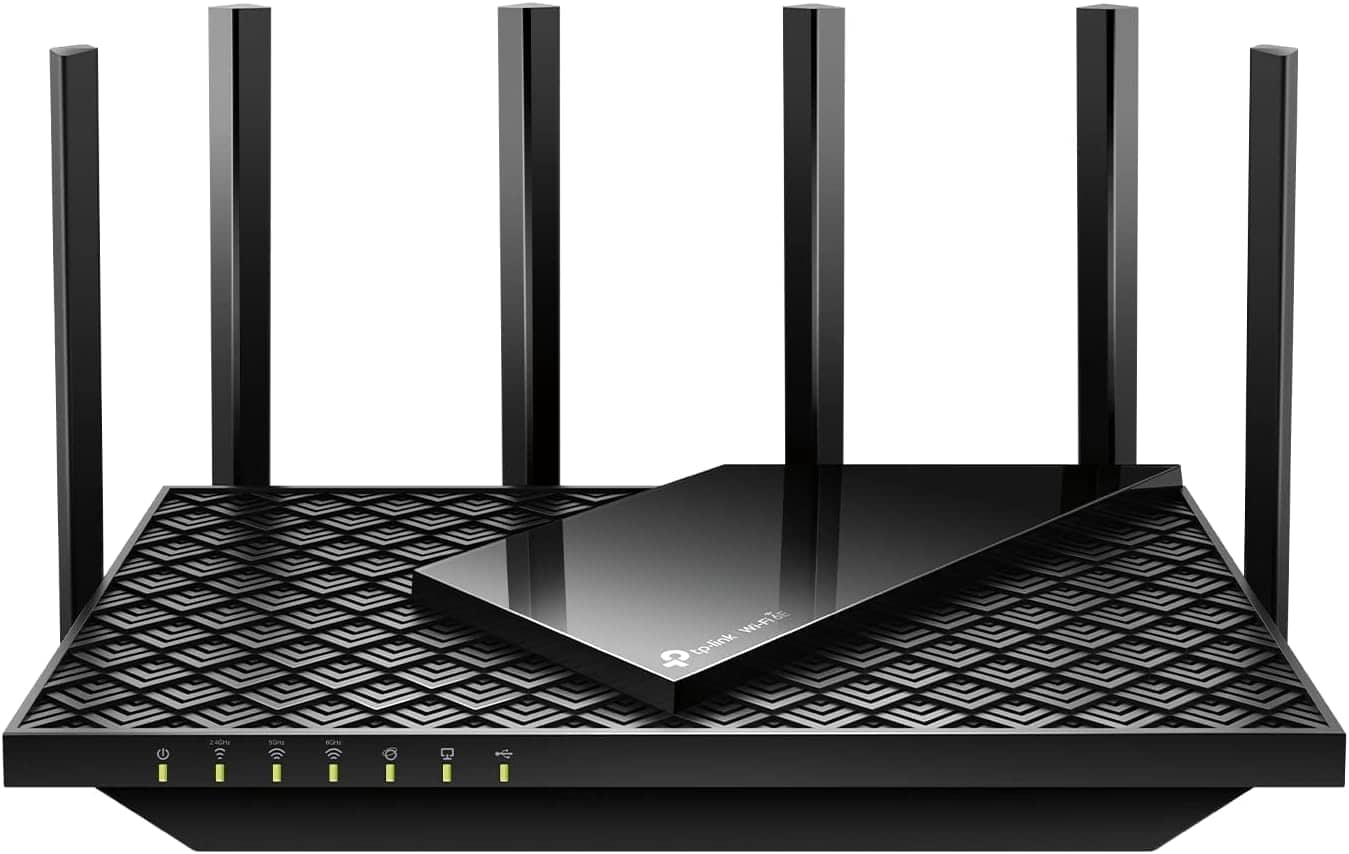
- Wireless Standard: Wi-Fi 6E (802.11ax)
- WiFi Range: Up to 3,000 Sq Ft
- Supported Internet Plan: Up to 1 Gbps
- 2.4GHz Speeds: 574 Mbps
- 5GHz Speeds: 2402 Mbps
- 6GHz Speeds: 2402 Mbps
- Number of Devices Supported: 200
- Ports: 1 x Gig WAN + 4 x Gig LAN + 1 x USB 3.0
- Processor: 1.7GHz Quad-Core
- RAM & NAND Memory: N/A
- App Support: Yes
In the penultimate position, I bring to you another TP-Link offering, this time a mesh system. TP-Link Archer AXE75, alongside the latest tri-band Wi-Fi 6E protocol and an additional 6GHz band, boasts a decently-powerful processor which works harmoniously with each other to boost its performance by a notch, much better than its older model.
Why is it a suitable choice?
Archer AXE75 with an extra 6GHz band has a maximum throughput capacity of 5400 Mbps, and band-wise speeds are as follows:
6GHz: 2402 Mbps, 5GHz: 2402 Mbps, 2.4GHz: 574 Mbps
Boasting a speed cap similar to my previous recommendation, I paired this mesh router with the same, i.e. Xfinity 1 Gbps plan, and the results were impressive. The band-wise download speeds for 6GHz, 5GHz, and 2.4GHz were 987 Mbps, 947 Mbps, and 554 Mbps, while respective uploads speeds were 365 Mbps, 324 Mbps, and 187 Mbps.
Courtesy of the additional 6GHz band and networking technologies like MU-MIMO and beamforming, the signals were clearer, and I could connect a few more devices to it without any lags.
Ports & Wired Speed
TP-Link boasts a decent arrangement of ports with five Ethernet ports on its rear panel, which are capable of imparting Gigabit of speeds. To test it out, I plugged in my Xbox 360 to the ports and got speeds of 987 Mbps and 387 Mbps, a tad higher than what it got when connected to the 6GHz band. So, the ping fell from 4ms to 2ms, boosting the gameplay experience.
WiFi Coverage & Device Capacity
Boasting a six-antenna setup, you don’t have to worry about coverage once you set it up. At a stretch, its signals can travel up to 2,400 Sq Ft without any signal drops, which might be more than enough for any two to three-bedroom setup. Besides, courtesy of networking technologies, I could connect up to 65 devices, which is on par with most top-tier models on my list.
Security Features
Aside from HomeShield's basic features, there is a WPA3 security standard, an SPI firewall, and a VPN. Courtesy of the SPI firewall, no unauthorized devices could access your network ecosystem, and the WPA3 standard keeps the data transferred over the network in an encrypted form, thereby keeping it safe. The VPN server lets you access any website without revealing your identity.
Other than that, similar to other TP-Link networking devices, there’s subscription-based HomeShield Pro with some additional features like malware blocking, malicious website identification and elimination, and others.
Conclusion
Priced in a mid-tier range, TP-Link Archer AXE75 is one of the best Wi-Fi 6E tri-band routers available out there. It’s indeed a smart choice for users looking for a future-proof device compatible with most high-speed plans to launch in the future. Although there’s no multi-gig port available, you can still connect to the Gigabit Ethernet ports to get faster throughputs.
Pros
- Reasonably priced
- Additional 6GHz band
- Solid throughput performance
- Easy to install
- Includes HomeShield software
Cons
- Some features require a subscription
- No multi-gig ports
6. Cheap Yet Best Tri-Band Router: Linksys MR9000
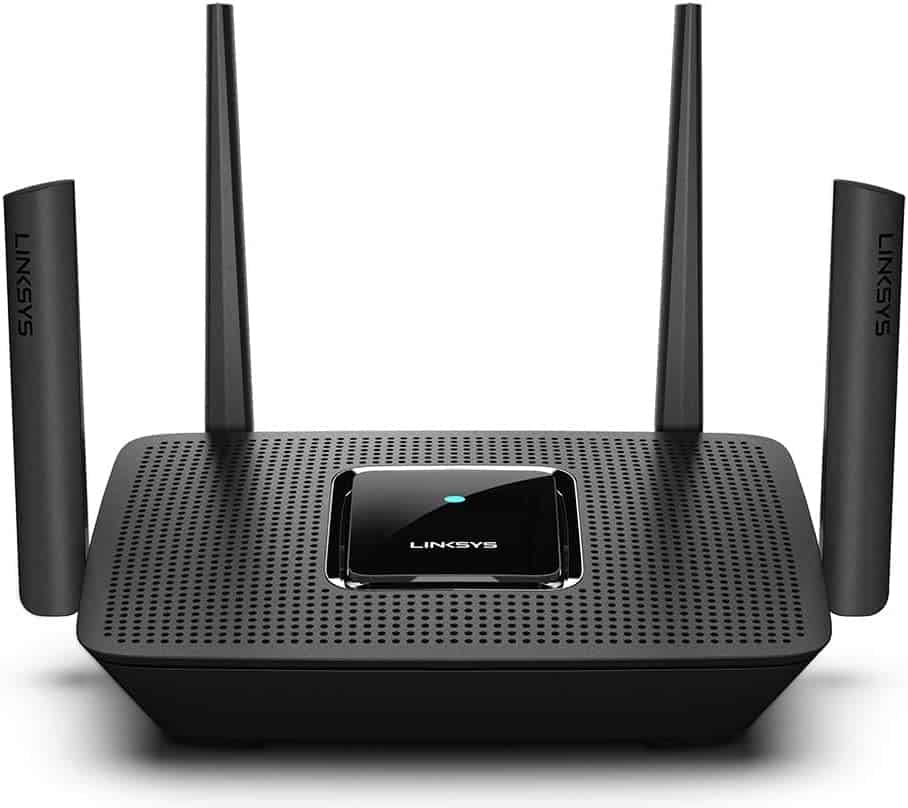
- Wireless Standard: Wi-Fi 5 (802.11ac)
- WiFi Range: Up to 3,000 Sq Ft
- Supported Internet Plan: Up to 500 Mbps
- 2.4GHz Speeds: 400 Mbps
- 5GHz Speeds: 867 + 1733 Mbps
- Number of Devices Supported: 25+
- Ports: 1x Gig WAN + 4 x Gig LAN + 1 x USB 3.0
- Processor: N/A
- RAM & NAND Memory: 512MB + 256MB
- App Support: Yes
The final product on my list is a budget-friendly tri-band router, Linksys MR9000, that boasts a decent range of features to deliver reliable and effective performance. Being a mesh system, its antennas are powerful enough to send signals across your three-bedroom apartment without leaving any weak or dead network spots.
Besides, networking technologies like beamforming, MU-MIMO, and others boost your signal strength.
Why is it a suitable choice?
This tri-band router from Linksys, with WiFi technology and a powerful processor, has a maximum throughput capacity of 3000 Mbps, with speed distribution with respective bands:
5GHz (1): 1733 Mbps, 5GHz (2): 867 Mbps, 2.4GHz: 400 Mbps
But the routers don't get you the performance level mentioned on your spec sheet. Pairing a 500 Mbps AT&T fiber plan got me download speeds of 487 Mbps, 357 Mbps, and 214 Mbps, respectively, for 5GHz (1), 5GHz (2), and 2.4GHz bands. At the same time, upload speeds for the respective bands were 204 Mbps, 115 Mbps, and 65 Mbps. That is decent output for a WiFi 5 router.
With such outputs, getting any of your internet-bound tasks must feel like a walk in the park. Theoretically, you can stream 4K movies on 20 of your devices on Netflix, consuming 25 Mbps bandwidth for each movie.
Ports & Wired Speed
Linksys MR9600 ingrains five Ethernet (1 WAN and 4 LAN) ports to get you an interference-free internet using experience whenever you connect to it. You can upgrade your internet plans if you have limited devices in hand.
The ports with the Gigabit plan had a speed output of 974 Mbps and 347 Mbps, which reduced the ping value from 5ms to 3ms, which is a major upgrade, especially when you’re gaming.
WiFi Coverage & Device Capacity
The WiFi 5 mesh system has four in-built antennas capable of expanding the coverage area to 2,500-2,600 Sq Ft, a few hundred feet more than its predecessor. Furthermore, technologies like MU-MIMO and beamforming let me connect 18 devices simultaneously. These devices include gaming consoles, laptops, mobile devices, smart TVs, and others.
Security Features
Security-wise, MR9600 has in place limited features and customization options available, making it unsuitable for offices and large residential spaces. Although features like guest network access, auto-firmware update, WPA2 personal, and AES link encryption can protect limited devices.
With respect to parental controls, there are features like scheduling network access, network pausing, and website blocking.
Conclusion
In conclusion, Linksys MR9600 might not be one of those high-end tri-band devices, but it passed most of my performance tests with decent results. And considering the price it comes in, it’s indeed a valuable purchase if you need a cheap yet reliable WiFi 5 router to install in your home and workspace. However, security is the area where this area bogs down, taking it down to the last.
Pros
- 2,500 Sq Ft Coverage
- Quad-core processor
- MU-MIMO, beamforming
- Decent speeds and coverage
Cons
- Limited security features
Frequently Asked Questions
As far as my tests go, Netgear Nighthawk AXE500 is the fastest tri-band router you can get. Features like WiFi 6E with an additional 6GHz band, cutting-edge processing ability, multi-gig ports, and powerful antennas can get you speeds up to 1.9 Gbps with your 2 Gbps internet plan.
If you reside in a congested area or possess many devices, a tri-band router can get you powerful and stable connections across multiple devices.
There are multiple benefits of a tri-band router, which include:
– A tri-band router uses three frequency bands and connects you to the fastest and least congested network every time.
– Such a router has a greater throughput capacity than its older counterpart
– Radio waves from devices like remotes, wireless phones, baby monitors, and other devices interfere with the 2.4GHz band
Dual-band routers offer faster speeds and support 2.4GHz and 5GHz frequencies. On the other hand, Tri-band routers do the same except for an additional 5GHz or 6GHz band, which is great, especially if you have multiple streaming devices in your house.
Verdict
Tri-band routers are a holy grail for users who are experiencing inconsistencies or lags with dual-band routers, courtesy of an additional band. I hope reading through the list has helped you understand the nitty-gritty of these devices and helped you make an informed purchase decision. But if you still can’t pick, here’s a curated list for you:
- Go for the Netgear Nighthawk RAXE500 with an additional 6GHz band if you are interested in taking a top-tier router with advanced features to deliver cutting-edge performance.
- If you don’t want to spend an exorbitant amount of money on routers yet need a reliable device, then TP-Link Archer AX90 with quality features is available at half the cost of the Netgear device.
- Lastly, if you want a budget tri-band router with reliable performance in terms of speeds and coverage, Linksys MR9000 is your go-to device.
With that comes an end to the list of some top-rated tri-band routers. I hope you find the guide informative and a perfect anchor to sail your boat in the right direction. Goodbye and take care!


